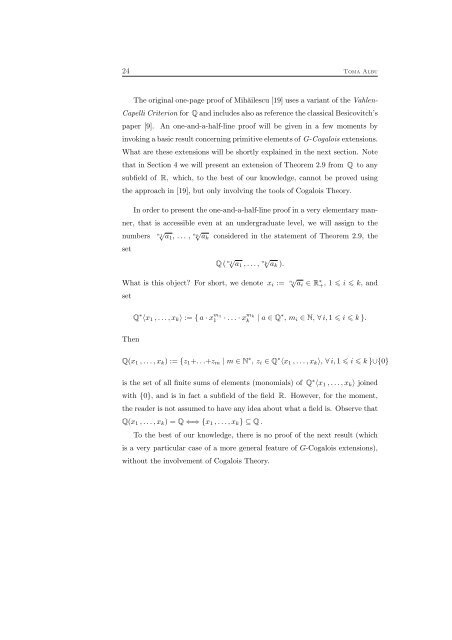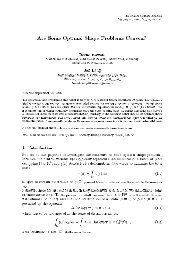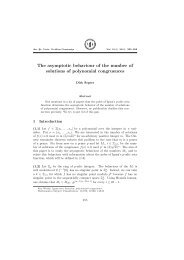the irrationality of sums of radicals via cogalois theory
the irrationality of sums of radicals via cogalois theory
the irrationality of sums of radicals via cogalois theory
- No tags were found...
You also want an ePaper? Increase the reach of your titles
YUMPU automatically turns print PDFs into web optimized ePapers that Google loves.
24 Toma AlbuThe original one-page pro<strong>of</strong> <strong>of</strong> Mihăilescu [19] uses a variant <strong>of</strong> <strong>the</strong> Vahlen-Capelli Criterion for Q and includes also as reference <strong>the</strong> classical Besicovitch’spaper [9]. An one-and-a-half-line pro<strong>of</strong> will be given in a few moments byinvoking a basic result concerning primitive elements <strong>of</strong> G-Cogalois extensions.What are <strong>the</strong>se extensions will be shortly explained in <strong>the</strong> next section. Notethat in Section 4 we will present an extension <strong>of</strong> Theorem 2.9 from Q to anysubfield <strong>of</strong> R, which, to <strong>the</strong> best <strong>of</strong> our knowledge, cannot be proved using<strong>the</strong> approach in [19], but only involving <strong>the</strong> tools <strong>of</strong> Cogalois Theory.In order to present <strong>the</strong> one-and-a-half-line pro<strong>of</strong> in a very elementary manner,that is accessible even at an undergraduate level, we will assign to <strong>the</strong>√nnumbers 1 a1 , . . . , √ n k a k considered in <strong>the</strong> statement <strong>of</strong> Theorem 2.9, <strong>the</strong>setQ ( √ n 1a 1 , . . . , √ n ka k ).What is this object? For short, we denote x i := √ n i a i ∈ R ∗ +, 1 i k, andsetThenQ ∗ 〈x 1 , . . . , x k 〉 := { a · x m 11 · . . . · x m kk| a ∈ Q ∗ , m i ∈ N, ∀ i, 1 i k }.Q(x 1 , . . . , x k ) := {z 1 +. . .+z m | m ∈ N ∗ , z i ∈ Q ∗ 〈x 1 , . . . , x k 〉, ∀ i, 1 i k }∪{0}is <strong>the</strong> set <strong>of</strong> all finite <strong>sums</strong> <strong>of</strong> elements (monomials) <strong>of</strong> Q ∗ 〈x 1 , . . . , x k 〉 joinedwith {0}, and is in fact a subfield <strong>of</strong> <strong>the</strong> field R. However, for <strong>the</strong> moment,<strong>the</strong> reader is not assumed to have any idea about what a field is. Observe thatQ(x 1 , . . . , x k ) = Q ⇐⇒ {x 1 , . . . , x k } ⊆ Q .To <strong>the</strong> best <strong>of</strong> our knowledge, <strong>the</strong>re is no pro<strong>of</strong> <strong>of</strong> <strong>the</strong> next result (whichis a very particular case <strong>of</strong> a more general feature <strong>of</strong> G-Cogalois extensions),without <strong>the</strong> involvement <strong>of</strong> Cogalois Theory.






